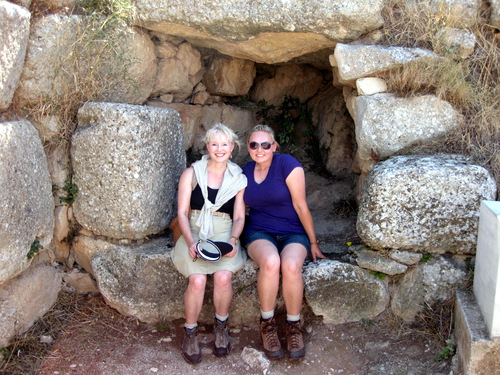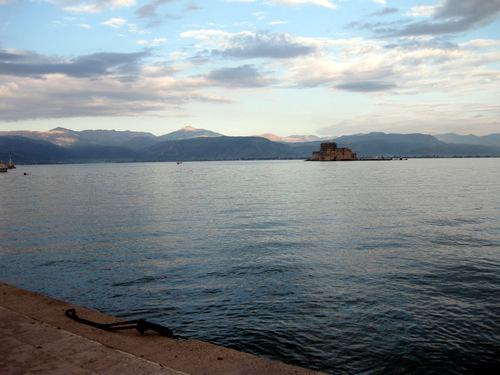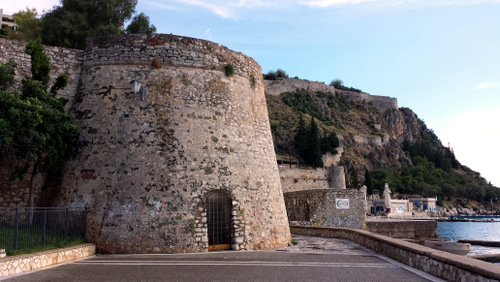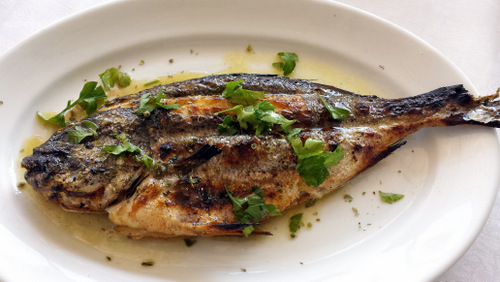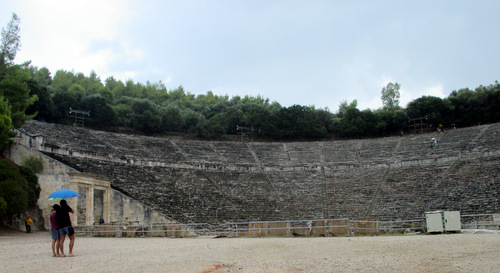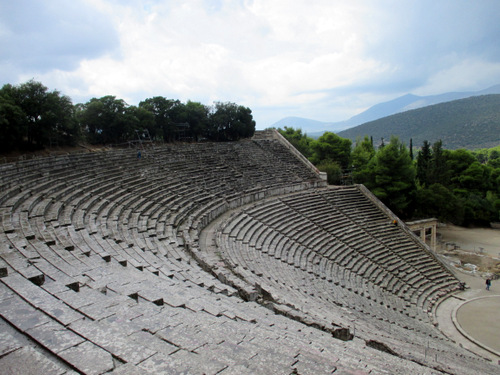First of all, Nafplio (Nauplion):
Nafplio is the loveliest town and it’s where we arrived on the first evening of our Tour and stayed throughout. It’s situated on a gulf, with restaurants facing the sea, narrow pedestrian streets — such a relief after noisy Athens — balconies, French doors and spectacular fortresses crowning the heights.
Second Day: Troezen and Epidauros
We had an early morning in store, driving first to Troezen to see what had been identified to Pausanias, in his travels in the second century AD, as the Theseus Stone. According to the legend, Aethra, Theseus’ mother, had slept with both the god and King Aigeus of Athens at the temple of Poseidon in a single night, later giving birth to the hero. Aigeus left his sword and his sandals under a great stone with a firm command that his identity not be revealed until the day that their child could lift it and find what lay beneath. We had a good laugh as Sandy and Jean-Pierre lifted it in charade and Olivier filmed.
Troezen was one of Poseidon’s earliest cult centers, which syncs perfectly with Mary Renault’s portrayal in The King Must Die. (The city contributed ships to the Greek invasion of Asia in the Iliad. In the 6th Century, Themistocles sent the Athenian women and children there for protection from the Persians, when they abandoned Athens to be sacked and instead defeated the Phoenician fleet at sea. The oracle at Delphi had revealed that Athens would be protected by “wooden walls.”)
From the Stone, we walked up to a Hellenistic watchtower, identifiable by the drafted margins on its corners, on which a Byzantine top had been added. At least that’s what I understood at the time. Since then I’ve read that the Diateichisma Tower was originally built in the 5th century BC, but the superstructure is medieval. In any case, it didn’t exist in Theseus ‘ day.
We continued on along a mountain path to reach the Devil’s (daimon’s) Bridge over a narrow gorge, an ancient construction and one of the last remaining intact bridges in Greece.
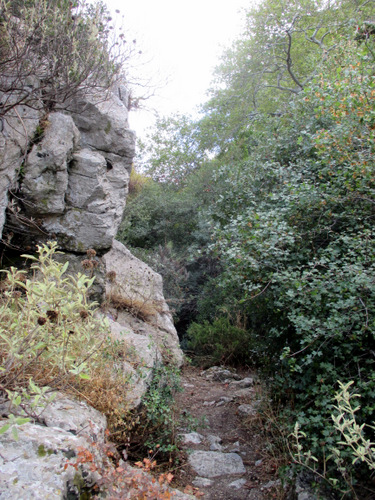 Sandy said it was exactly the sort of place that the Greeks would have believed inhabited by a local spirit or daimon.
Sandy said it was exactly the sort of place that the Greeks would have believed inhabited by a local spirit or daimon.
There is a small aqueduct running along one side of the bridge. The path we were on leads along the stream to a town on the other side of the mountain. I could imagine Theseus traveling towards his fateful meeting with Gerkyon and afterwards hunting bandits along just such a path. I imagine it’s the reason The King Must Die was on our Tour reading list. I’m glad I’d just reread it. (Geneia had read The Last of the Wine instead – she’s read The King Must Die before – according to my instructions, so she had a feel for Classical Athens.) Interestingly, Troezen’s deity, Poseidon, predates Zeus, and his name means Lord of the Earth in Indo-European. In The King Must Die,Mary Renault makes much of the sky god that is displacing the older, earth-mother religion of mainland Greece, and portrays Crete as a stronghold of the old religion. The novel was written in 1958, and there is much material to consider in understanding the religion of Bronze Age Greece, many threads, but the greater antiquity of an earth-shaker, perhaps chthonic (within the earth) god is interesting.
From Troezen we stopped for a seaside lunch next to a large bay. We were served fresh cucumber, tomato, feta, onion and lettuce salad, fresh steamed broccoli, green beans with lemon and grilled Dorada fish, all with the most luscious Tzaziki Sauce, full of garlic and dill, I’ve ever tasted. It was all local and terrific.
It began to rain when we reached Epidauros and we walked up to the theater in a sprinkle. It held off long enough for us to have a thorough look at it and climb to the top.
To demonstrate the acoustics, we were invited to declaim something from the center stone. The Brits and Belgians had no trouble quoting Shakespeare and Jean-Paul began to recite the Iliad in Greek. He recited about three lines and I would have loved to pick up exactly where he left off — that would have been so cool — but by the time it was my turn, I had to recite all seven of my lines in order to remember any of them. (My obscure party trick finally came in handy.) A number of our party had seen Greek plays performed live in this theatre. (How handy it is to live in Britain or some other European country! The USA is a very long way away.) They are a very well-traveled lot. I learned over lunch that Jeremy and Linda are Sibelius fans and had just spent a week at a Sibelius Festival in Lahti, Finland, where a new concert hall has so perfected the acoustics; they heard parts of his music which they’d never heard before.
I can’t make sense of the map we were given now, but will relate the order in which we saw things in the compound of Asklepios. First of all we were shown a hotel, which was composed of a square of adjacent rooms, where visitors could stay in Roman times. Then there is a Greek bath house, where cold water was used for their ablutions. The Romans later built another luxury model for themselves, as they didn’t appreciate the Spartan values of their originators.
After that we walked past the very large Temple of Asklepios wherein a Roman Odeon was added in the center. (Sandy challenged us to each write an Ode to be recited at the end of the tour.) There was a Tholos under reconstruction. (I like reconstruction, because it helps the imagination, makes sense of the remains and it appears to me, protects them as well.) The Tholos was built between 360 and 300 BC. It was the center of the chthonic (underworld) mystery cult of Asklepios, once a Homeric hero and later a god. Sculptures there were credited to the Argive architect and sculptor, Polykleitos, who is also credited with the magnificent theater.

There was a building, the Enkoimeterion, a dormatory where patients who had come to the Temple of Asklepios could stay while they waited to be healed.
I knew I have seen a painting in the style of Tadema of suppliants sleeping in the Temple, waiting to receive a dream from the god with a course of treatment. It turns out that it is by Waterhouse and I saw it in Montreal!

A Sick Child Brought to the Temple of Aescapulius, John Waterhouse 1877
Sandy told us about how the Greeks had discovered the meridians of the body along which Chinese Acupuncture is practiced. Hippocrates of Kos had asserted that the blood vessels ran along these meridians.
The Greek approach to healing: First they had to confess what moral wrong had brought on the illness. Once that was cleared up, they became partners in their own cure. There seem to have been any number of sacred (white) snakes about the precinct (Greek name, Ophis), who might come out and lick a wound, for example, but be remembered in the dream as a handsome young man who performed the act, then spoke to the sufferer, giving them advice. These snakes were shipped all over the Mediterranean for use at other Asklepions. One is wrapped around the symbolic Staff of Asklepios to this day the symbol of medicine. We made it to the Museum before it began to rain again. There were many statues of Hygiena, Asklepios’ daughter, Athena and Asklepios himself. The thing I liked most were the Roman rain gutters, which were formed of terracotta acanthus leaves, punctuated with lion’s heads through which water spouted.
All the terracotta pieces were elegantly painted with designs in black, white and red. As soon as we reentered the coach, it began to pour in earnest. Incidentally, Asklepios is not a Greek name. Sandy said there was some discussion on the part of etymologists that the name might come from “assili-peha,” a Hittite word meaning”well-being.” I enjoyed that connection.
On the bus ride home we passed a Mycenaean Bridge. The bridge belonged in Mycenaean times to a highway between the two cities, which formed part of a wider military road network. The structure is 72 ft long, 18.4 ft wide at the base and 13 ft high. The width of the roadway atop is about 8 ft. The sophisticated layout of the bridge and the road indicate that they were specifically constructed for use by chariots. Built ca. 1300–1190 BCE, the bridge is still used by the local populace. Imagine! It is certainly over three thousand years old.
Miranda took us for a short walk to show us the city-center of Nauplion, Syntagma (Constitution) Square, but we didn’t continue because of the weather. Nauplion was the first capital of independent Greece. More about that tomorrow. There is a Venetian building, now the Archaeological Museum, but I don’t know its original purpose.
In the evening I visited with Dominique. I found out she hosts concerts for 100 people in her salon. Her daughter plays the harp, I think, and is marrying a man who plays the Turkish lute. Their honeymoon plans involve gypsying around Europe with a horse and caravan!
We left dinner last night following Bernard and Lindsay out to find a cocktail. Bernard had noticed a restaurant/bar, where he was sure he could find a good Manhattan, which we repaired to. There was loud music playing inside, but we situated ourselves outside around the corner, where we could hear ourselves think. I ordered a Manhattan, Lindsay a G & T, Geneia a Tequila Sunrise, Jean-Paul a Famous Grouse and John, a Napoleon brandy. (John is 89 years old and gamely visiting all the sites with us, walking up hills and clambering over rocks in spite of being bent over. I can’t imagine my mother doing the same on her own at his age. Something to aspire to.) Later we were joined by Olivier and Dominique. We ended up talking about the upcoming last season of Downton Abbey with interest all around. What fun! It just goes to show you how the BBC brings people together!

